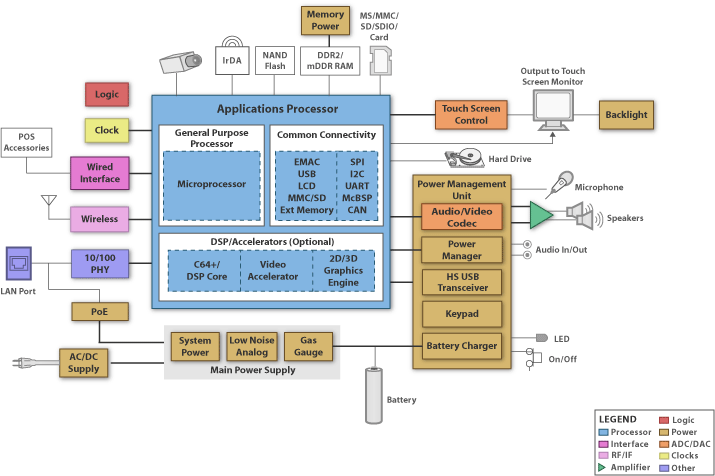
Design Considerations
The proposed solution can be used to design equipment that can function as one of three industrial applications namely Single Board computer, Human Machine Interface panel (also known as Operator Interface Panel) or Point of Service kiosks. The fundamental requirement of each of these applications is a powerful processor core capable of superior video processing/graphic performance, providing a wide variety of highly integrated peripheral options.
Processor Selection
Knowing processor performance requirements is useful when choosing a TI embedded processor for industrial applications. Particular care should be taken, however, to include a realistic estimate of the performance required by the human-machine interface (HMI), particularly involving video, 2-D and 3-D graphics. Other considerations, such as peripheral mix, are also highly relevant. Once a performance requirement is determined, applications roughly break down into three categories for applications requiring:
• Less than 150 Dhrystone MIPS: MCUs based on the ARM Cortex-M3 core provide the best price and performance
• From 150 to 500 MIPS: MPUs based on the ARM9 core are likely to be the best choice
• From 500 to 1,500 MIPS: MPUs based on the Cortex-A8 core are best for higher computing requirements
Core Subsystem components:
• Applications Processor: The OMAP processor family of multimedia application processors lend themselves extremely well for these applications as it provides superior computing performance. In addition, the highly integrated peripheral set includes many system level components that will reduce the overall BoM and PCB size. TI's SmartReflex™ power and performance management technologies reduce power consumption, dynamically controlling voltage, frequency and power based on device activity, modes of operation, and temperature.
• SBC: Single Board Computers (SBC), which enable the shortest development time, are off-the-shelf compact motherboards with I/Os on-board, and because of their power density, low-power CPUs are almost always used. The targeted OMAP35x platform includes key features such as:
o Sitara ARM® Processor which features:
Powerful ARM® Cortex™-A8 up to 1GHz operation optimized for low power consumption
Wide peripheral set includes:UART, SPI, I2C, USB, Ethernet
Display support
Production-ready reference platforms
TI-RTOS, Linux Mainline, Andriod and Large 3P ecosystem support
o The c64x+ DSP-based video subsystem (up to 720 HD resolution)
o OpenGL ES 2.0 compatible graphics hardware (up to 10 M polygons per second)
• HMI: A Human-Machine Interface (HMI) system’s usability is determined by the its processing power, its ability to render complex and reality-like screens, its fast response time to user input and its flexibility to handle various levels of operator interactions. Texas Instruments OMAP devices have the processing power, the graphical accelerators and the peripherals needed to address the increasingly demanding HMI space. The laptop-like computing performance of OMAP enables new features and functionalities to now be included in any HMI without reaching prohibitive costs.
• POS: Texas Instruments is offers solutions for the electronic Point of Service (POS) market with processor platforms that offer USB 2.0 and EMAC connectivity.
o OMAP-L1x products integrate an ARM9 at 300MHz and an optional floating or fixed DSP engine at 300MHz (total system performance of 600MHz) as well as the richest set of peripherals in its class. Maximum 10mW standby with o OMAP35x products offer an operating power of 500mW (typ) and standby power as low as 5mW. Peripheral integration on these products includes EMAC, CAN, USB OTG HS 2.0 PHY, 1.8V/3.3V IO, and LPDDR/DDR2 support.
• Connectivity: Wireless connectivity to Bluetooth, WLAN, and 3G networks is available as well as wired industry-standard communications such as CAN, UART, USB OTG, I2C and 10/100 Mbit Ethernet. These interface options enable hooking up the system to a myriad of external peripherals and accessories, depending on the need of the end application.
• Touch Screen Controller: TI's touch screen controllers provide a low-power, high-performance solution that caters well to the needs of the Touch Screen Display. The controllers offer programmable resolution ( 8 or 12-bit), the control logic to measure touch pressure, and touch screen measurement preprocessing to reduce bus loading, thus reducing the consumption of host processor resources that can then be redirected to more critical functions.
Download Full Block Diagram Below
Advertisement

Learn more about Texas Instruments





